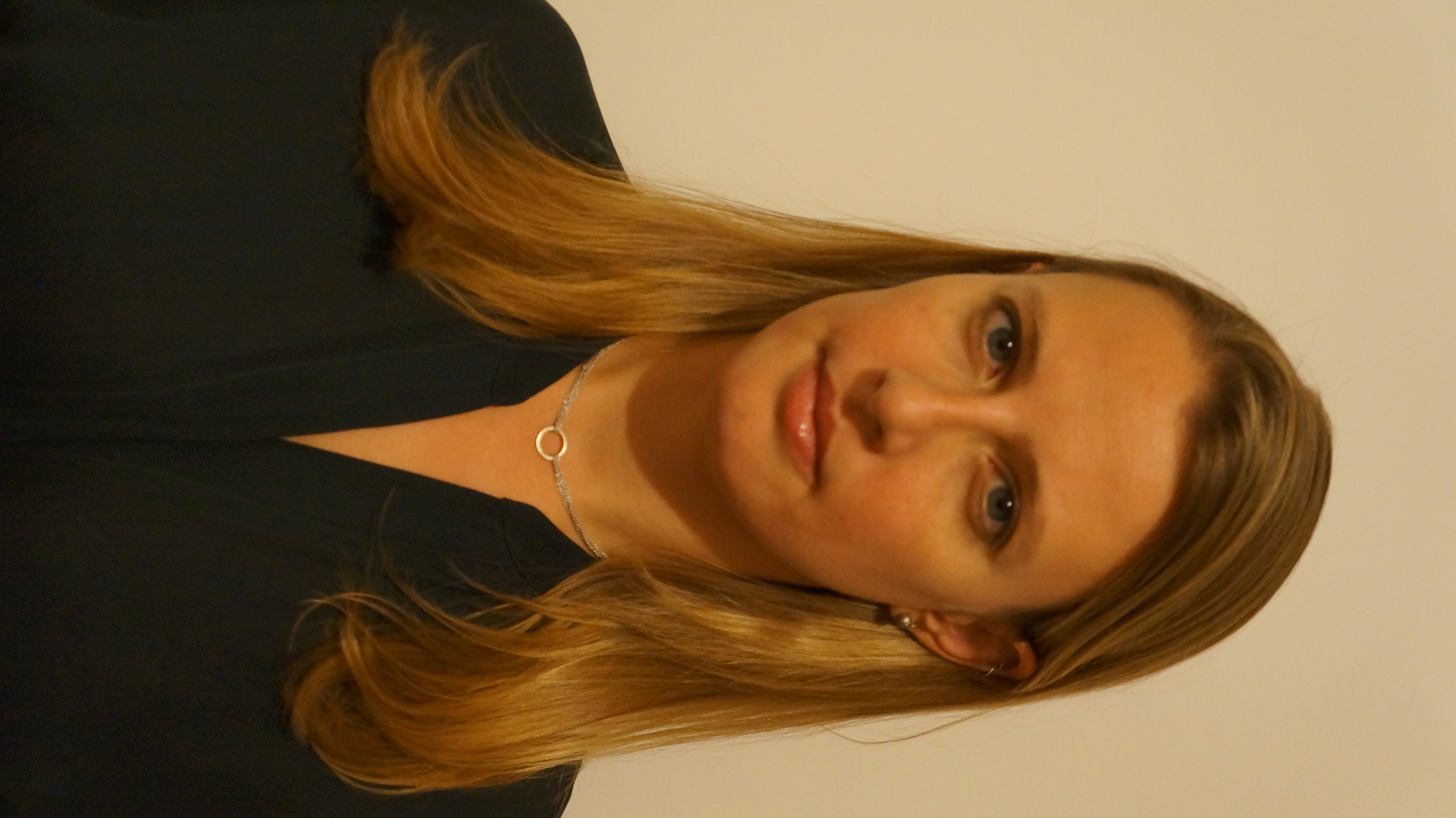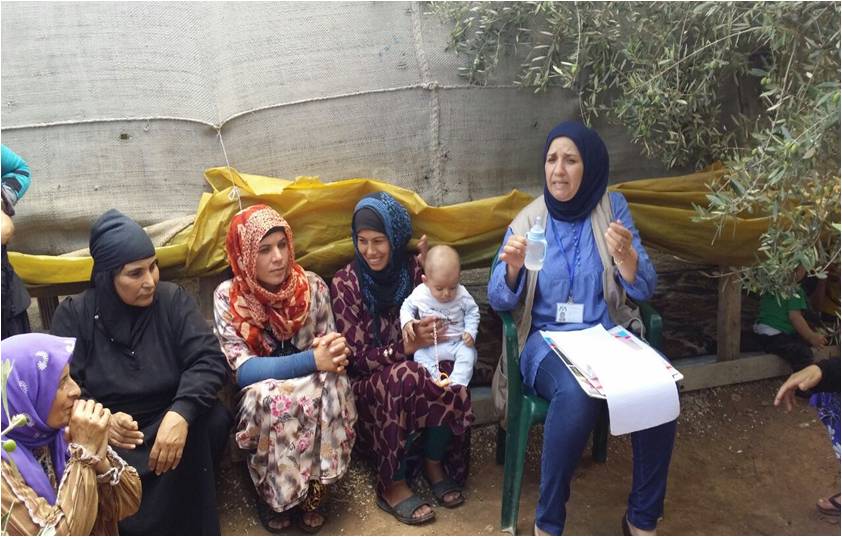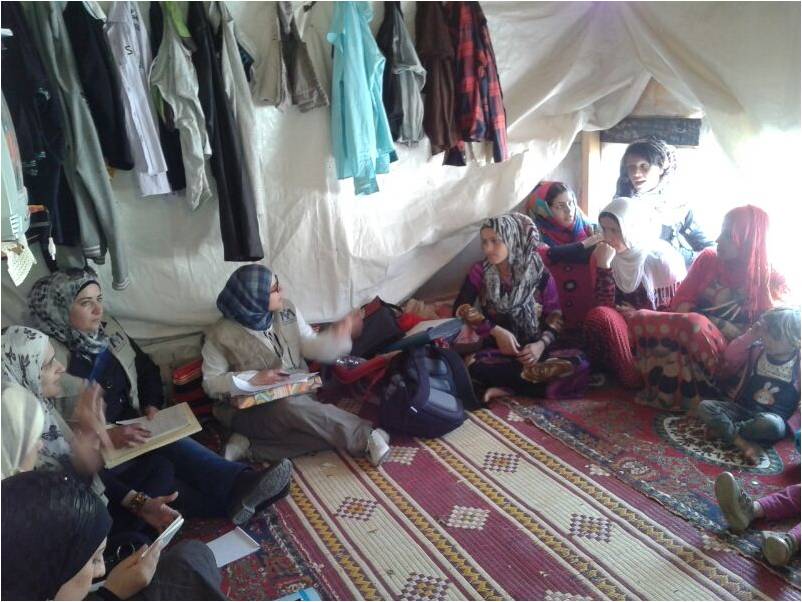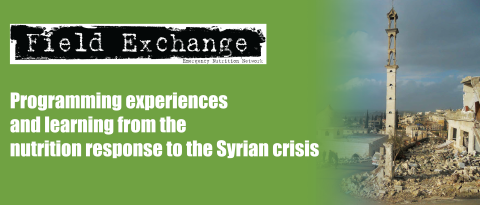Integrating community-based nutrition awareness into the Syrian refugee response in Lebanon
By Julie Davidson and Christina Bethke
 Julie Davidson is currently the Team Leader for International Medical Corps Emergency Response in Erbil, Iraq. She lived in Beirut for 5 years working for local organisations in the Palestinian refugee camps and as the Programme Coordinator for International Medical Corps.
Julie Davidson is currently the Team Leader for International Medical Corps Emergency Response in Erbil, Iraq. She lived in Beirut for 5 years working for local organisations in the Palestinian refugee camps and as the Programme Coordinator for International Medical Corps.
Christina Bethke is currently the Health Coordinator for International Medical Corps in Lebanon. Previously, Christina served for three years as Country Director for Last Mile Health in Liberia.
International Medical Corps wish to thank its donors including UNHCR, Bureau of Population, Refugees and Migration (BPRM) and Department for International Development (DfID). Special thanks to Dr. Ali Zein of the Lebanon Ministry of Public Health for his ongoing support and technical contributions to International Medical Corps’ health education programme. Additionally, the Lebanon team is very grateful to Caroline Abla, Director of Nutrition and Food Security for International Medical Corps, for her continuous guidance. Finally, International Medical Corps acknowledges the leadership and dedication of Lamia Aassaf, Health Education Programme Manager.
 International Medical Corps in Lebanon
International Medical Corps in Lebanon
International Medical Corps commenced operations in Lebanon in response to the July 2006 war, playing an integral role in the provision of relief to conflict-affected populations. International Medical Corps remained in Lebanon following the August 2006 ceasefire to assist with reconstruction efforts, maintaining a strong presence in the country by implementing a diverse set of development initiatives, ranging from health and mental health activities to education, livelihoods development, and water and sanitation programmes. In response to the influx of Iraqi refugees in the country in 2007, International Medical Corps commenced a targeted refugee assistance programme consisting of support to clinics and capacity building for health care professionals, civil society organisations, and communities to improve access and quality of health care service available to Iraqi refugees. This platform of programmes formed the basis of International Medical Corps’ role in the Syria response in Lebanon.
Context overview
Syrian refugees began arriving in Lebanon in March 2011, following anti-government protests. Most took refuge in villages in northern Lebanon and were accommodated by Lebanese communities. Initially, the number of refugees grew slowly, allowing the humanitarian response to keep apace. However, beginning in January 2013, the rate of influx increased sharply reaching nearly 50,000 new registrations on a monthly basis1. Newly arrived refugees settled mainly in Bekaa valley and southern areas of the country and eventually moved into the Beirut and Mount Lebanon regions. The population of registered Syrian refugees in Lebanon hit the one million mark in May 2014, making Lebanon the country with the highest number of refugees per capita in the world2. The actual ratio may be even higher due to large numbers of refugees that have chosen not to register with UNHCR, thus complicating the tracking and monitoring of population figures. The Government estimates the number of unregistered Syrian refugees may be as high as 400,000 individuals3.
The response required to meet the needs of such a rapid and proportionately massive influx of refugees into Lebanon has been in a context of declining shelter options, as host communities are increasingly unwilling or unable to accommodate such large numbers and formal camp settings for Syrians have yet to be established due to political sensitivities. Consequently, informal settlements and collective shelters spread rapidly across the country and provide shelter ranging from basic plastic sheeting to housing in unfinished and abandoned buildings. Sixteen percent of the Syrian refugee population now resides in these settings4.
The speed and geographic spread of the refugee population has presented numerous challenges for all sectors, especially within the health sector, including:
- Access and information: New arrivals are difficult to monitor – often relocating numerous times within the country, thus resulting in ever-changing demographics at the community level. Providing health care for a population in constant flux is particularly challenging for health care actors. Presently, the humanitarian response is lacking a uniform system for informing the newly arrived population of services available to them. The health care system in Lebanon is highly privatised and differs significantly from that in Syria, resulting in unexpected expenses and often confusion about how refugees should access care. Additionally, many refugees have reportedly faced discrimination from the community and/or health care providers while seeking treatment at certain facilities.
- Lack of standardisation: To date, there is no standard package of services among health actors and the quality of services often varies dramatically between facilities. While some donors provide subsidised services exclusively to refugees registered with UNHCR, others may include host communities within their targeted populations. Further, eligible beneficiaries may be limited to certain vulnerable groups, such as children under 5 years or pregnant women, while other providers offer coverage to anyone in need. Finally, the cost of services at supported facilities also ranges from free to cost-sharing models. Combined with the factors mentioned above, this creates a confusing system that refugees must navigate in order to receive the most basic health care services, such as vaccinations and ante-natal care.
- Secondary health care: Prior to the crisis, Syria’s public sector health system provided nearly all patients with access to heavily subsidised care. In contrast, the secondary health care system within Lebanon is privatised with patients bearing a significant portion of the cost. The UNHCR model for secondary health care for Syrian refugees designates primary health care (PHC) centres as the entry point for specialised and hospital care. However, the practice of PHC centres as “gate keepers” is not fully developed within Lebanon’s health system nor is it familiar to many refugees. With the additional challenges of large case loads and limited funding support for hospital care, proper referral and follow-up of refugee patients is difficult.
- Determinants of health: Acute respiratory infections, diarrhoeal diseases, and skin diseases are the top contributors to morbidity among refugee patients who seek treatment at International Medical Corps s’ supported facilities. These conditions relate directly to hygiene and sanitation conditions, and are also linked to malnutrition. As growing numbers of refugees settle in informal settlements and collective shelters, overcrowding and insufficient water and sanitation are likely to cause an increase in communicable diseases and may also trigger the onset of secondary conditions, such as malnutrition in children suffering repeated incidents of acute watery diarrhoea5.
International Medical Corps’ Syrian refugee response
 International Medical Corps’ participation in the Syrian refugee response in Lebanon commenced in March 2011 after an initial influx of 5,000 Syrians to north Lebanon. The team established a mobile medical unit (MMU) in the Wadi Khaled area, becoming the first health actor to offer services to the arrivals. Since that time, the programme has expanded significantly, growing from its initial focus in the North to include the Bekaa, South, and Beirut and Mount Lebanon, thus mirroring the migration of refugees within Lebanon as they spread across the country. In addition to existing offices located in Beirut and South Lebanon, the expansion of Syrian refugee response operations necessitated the establishment of three new offices, in Akkar, Bekaa, and Tripoli, between December 2011 and August 2013. Simultaneously, the team grew dramatically to include more than 350 staff and volunteers.
International Medical Corps’ participation in the Syrian refugee response in Lebanon commenced in March 2011 after an initial influx of 5,000 Syrians to north Lebanon. The team established a mobile medical unit (MMU) in the Wadi Khaled area, becoming the first health actor to offer services to the arrivals. Since that time, the programme has expanded significantly, growing from its initial focus in the North to include the Bekaa, South, and Beirut and Mount Lebanon, thus mirroring the migration of refugees within Lebanon as they spread across the country. In addition to existing offices located in Beirut and South Lebanon, the expansion of Syrian refugee response operations necessitated the establishment of three new offices, in Akkar, Bekaa, and Tripoli, between December 2011 and August 2013. Simultaneously, the team grew dramatically to include more than 350 staff and volunteers.
In order to respond to the dynamic nature of the Syrian response in Lebanon and address the challenges facing the health sector, International Medical Corps has implemented a comprehensive health programme with three main components6.
Primary Health Care (PHC) centres: International Medical Corps now supports more than 40 PHC centres across the country, concentrated in areas where vulnerable Syrian and Lebanese populations are located. International Medical Corps provides a standardised package of support to all its donor-funded PHC facilities. PHC centres receive funds to offset the impact of increased patient load and running costs, thus enabling affordable care. At the core of International Medical Corps’ support are cost-sharing mechanisms designed to address the protracted nature of the crisis; patients receive reduced-rate consultations and vulnerable persons also receive partial coverage for diagnostic procedures. Patients seeking services for specific conditions, such as gender based violence (GBV), malnutrition and TB, are provided with full coverage for both consultations and necessary diagnostic tests. Medications for acute conditions listed on Lebanon’s Essential Drugs List are also provided in-kind to clinics and dispensed to patients free of charge. At certain centres, vulnerable Lebanese patients may also benefit from this package of services.
In addition to standardised training on primary health care topics such as quality, communicable diseases, non-communicable diseases (NCDs) and reproductive health, International Medical Corps actively solicits specialised training from technical partners to further build capacity of clinical staff within its supported facilities. Topics include detection and treatment of malnutrition, early warning systems for communicable disease, and GBV referral. To reinforce training and monitor the quality of service delivery, International Medical Corps ’ team of health officers, pharmacists and physicians regularly visit clinics and collect and analyse aggregate data on number of beneficiaries. Between January and July 2014, PHC facilities supported by International Medical Corps provided more than 135,000 primary health care consultations with an average case load of more than 16,400 patients per month. International Medical Corps is now rolling out a programme to support a focal point who provides health education services, helping patients understand when to seek care, how to prevent onset or worsening of conditions, and what follow up is needed.
Mobile Medical Units (MMUs): In the early phase of the response, MMUs played a critical role in International Medical Corps’ response and the programme now supports eight MMUs – each operating within a specific region of the country. MMUs, by their very nature, can bring services to remote and/or vulnerable communities and ensure that they are able to access basic health services and receive appropriate referral information for more serious conditions, and have proven pivotal in an emergency where many refugee communities are in rural areas with little-to-no access to health care services. International Medical Corps’ MMUs are composed of at least one doctor, nurse, and outreach worker and are able to provide screening, basic PHC consultations, immunisation, referrals, and medication to anyone seeking care. All MMU services are provided free of charge.
In addition to basic service provision, MMUs have also allowed International Medical Corps to immediately respond to urgent situations. For example, MMUs were effectively deployed to border areas in the Bekaa in late 2013 and early 2014 to respond to the rapid influx of thousands of refugees following spikes in fighting in Syria. These units are able to treat, triage and refer patients as necessary, forming a key component of a frontline response.
Additionally, MMUs have been used in the detection of, and response to, disease outbreaks. Upon receiving reports of possible outbreaks or urgent health conditions from its community outreach team or other actors, International Medical Corps is able to rapidly deploy supported MMUs to the area to confirm the presence of the diseases and provide immediate treatment where appropriate. All findings are channelled through International Medical Corps’ strong links with surrounding PHC centres and Ministry of Health actors.
Community outreach: In order to address challenges related to information and health-seeking behaviours, International Medical Corps places particular importance on giving communities the tools and knowledge to be self-reliant and be their own best ‘First Responders’, targeting refugees in their own communities. A cadre of more than 130 outreach workers, mainly Syrian women, provides health education, promotion, early detection and referral services and support to refugees living in informal settlements and collective shelters.
To ensure sustainability and promote community acceptance of health messages, potential candidates are recruited from within the surrounding community. At present, all International Medical Corps community workers in Lebanon are female because they are culturally appropriate messengers for topics relating to the health of women and children. Recruitment of the women is a time intensive process. In addition to motivation and experience, cultural factors must be taken into consideration and the families of the women are often involved in initial discussions. It is standard practice to recruit more candidates than are needed because some level of attrition is expected due to demands of the work, difficulty grasping the training material and/or disapproval by family members. Following recruitment, in-depth group training sessions are provided for all potential candidates.
Rather than focusing on a single priority area, training for International Medical Corps’ community health workers covers a broad range of key health education topics, including breastfeeding, nutrition during pregnancy, antenatal and postnatal care, infectious and respiratory diseases, and the importance of immunisations, as well as topics related to complex emergencies such as water, sanitation and hygiene (WASH), food-borne diseases, and food safety. This intensive training lasts for seven days. Refresher trainings are periodically provided to strengthen participants’ knowledge, improve their communication skills and enhance their ability to effectively implement individual and group awareness sessions. In-depth trainings are also offered regarding key health priorities such as WASH and IYCF in emergencies.
International Medical Corps provides a modest stipend to its community outreach workers which improves overall retention of workers and allows in-depth investment in a woman’s learning and skills over time. A robust programme management structure with low ratios of workers to supervisors further bolsters opportunities for mentoring and retention of staff.
As a result of these strategic investments in recruitment, training, incentives and supervision, International Medical Corps’ community health workers possess broad core competencies. Strategically, this enables the outreach team to prioritise and respond to extremely urgent health topics as they emerge while continuing to play a key role in prevention and health promotion. For example, International Medical Corps ’ community outreach workers have been involved in hand washing campaigns, polio mobilisation and mop-up campaigns, identification of potential outbreaks – such as lice and scabies, and referrals to PHC centres while also providing a foundation of health knowledge to the community – particularly health messages about antenatal care and nutrition. Recently, the outreach team took part in a nutrition screening campaign of more than 16,000 children between 6 months and 5 years old living in Bekaa. This was easily integrated into the effort with minimal additional training because the outreach workers had already been properly oriented on key nutrition topics and information as part of their core training.
Preliminary results of Bekaa nutritional screening point to moderate acute malnutrition (MAM) levels of less than 0.5%7. Additionally, a recent refugee household vulnerability assessment by WFP found that 62% experienced mild food insecurity; 12.4% moderate food insecurity and just 0.4% severe food insecurity8. Appropriate response for community health actors should therefore include nutrition monitoring and prevention activities. As part of their routine health education and promotion activities, International Medical Corps community outreach workers continue to provide regular messages related to nutrition, breastfeeding and hygiene while referring any suspected malnutrition cases to the nearest treatment centre. Because nutrition is so heavily linked to other health determinants, ongoing attention to topics such as water, sanitation and hygiene (WASH) and antenatal care, for example, is key. If malnutrition prevalence increases markedly, it will trigger the team to initiate intensive focus on relevant nutrition response following a brief refresher from their supervisors.
Lessons learned
 Funding streams in an emergency response are variable and thus, sustainability should always be considered. To support lasting impact, International Medical Corps does not operate its own facilities but rather works to build the capacity of existing PHC centres through the provision of supplies and equipment, training of staff members and regular monitoring and support. This approach prepares local residents to be their own best First Responders and ensures the Lebanese population will benefit from this support - both immediately and in the long-term.
Funding streams in an emergency response are variable and thus, sustainability should always be considered. To support lasting impact, International Medical Corps does not operate its own facilities but rather works to build the capacity of existing PHC centres through the provision of supplies and equipment, training of staff members and regular monitoring and support. This approach prepares local residents to be their own best First Responders and ensures the Lebanese population will benefit from this support - both immediately and in the long-term.
This strategy of investing in existing community resources is further integrated into the four key components of International Medical Corps’ community health worker programme – recruitment, training, retention, supervision. By identifying and training local women, the community outreach workers, and providing a stipend to encourage long-term commitment to the programme, International Medical Corps is able to ensure core public health knowledge and capacity for response are embedded directly within the community.
This approach is especially appropriate for nutrition preparedness and response in a low prevalence setting such as Lebanon. In a dynamic crisis setting, it is difficult to predict which health priorities will emerge and when. Through our training programmes, we pass essential skills into local hands, preparing those in crisis-prone areas to better withstand adversity. International Medical Corps’ community outreach workers are broadly trained, thus enabling maximum flexibility and efficiency. International Medical Corps can quickly “train up” its team to respond to a specific emergency with minimal expense, rather than relying on community workers who are exclusively devoted to a single health topic such as nutrition.
Furthermore, a strong, community-based team enables the health programme to extend its reach from the PHC facility into the community itself, creating strong links, offering up-to-date knowledge about health conditions in the community and encouraging appropriate health-seeking behaviours.
International Medical Corps will continue building on its existing programming in order to respond to the needs of Syrian refugees, as well as vulnerable Lebanese host communities who have become overwhelmed due to the population influx. A continued focus on cost-efficiency, sustainability, and quality of services will be key components of all response programming over the coming months and years as levels of funding are likely to decrease.
For more information, contact: Christina Bethke, email: cbethke@internationalmedicalcorps.org
1 Based on UNHCR population figures from: http://data.unhcr.org/syrianrefugees/country.php?id=122
2 http://www.unhcr.org/533c1d5b9.html
3 http://globalnews.ca/news/1247786/un-syrian-refugees-hit-million-mark-in-lebanon/, http://www.independent.co.uk/news/world/middle-east/syria-civil-war-lebanons-refugee-count-passes-one-million-9235344.html
4 Lebanon: Inter Agency Mapping Platform (IAMP) – Informal Settlements, 1 September 2014
5 http://www.who.int/mediacentre/factsheets/fs330/en/
6 Note that IMC Lebanon also implements robust mental health programming for Syrian refugees using a community-based case management model and integration of mental health into PHC centers, though this has not been addressed in this article.
7 Preliminary results released by UNICEF during Bekaa Health Coordination Meeting, 28 August 2014
8 VASyr 2014. Preliminary results released by WFP, 2 July 2014. See article in this edition of Field Exchange.


